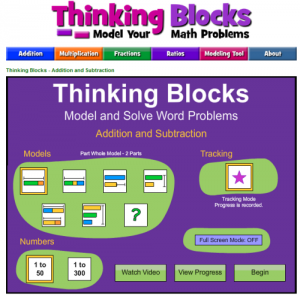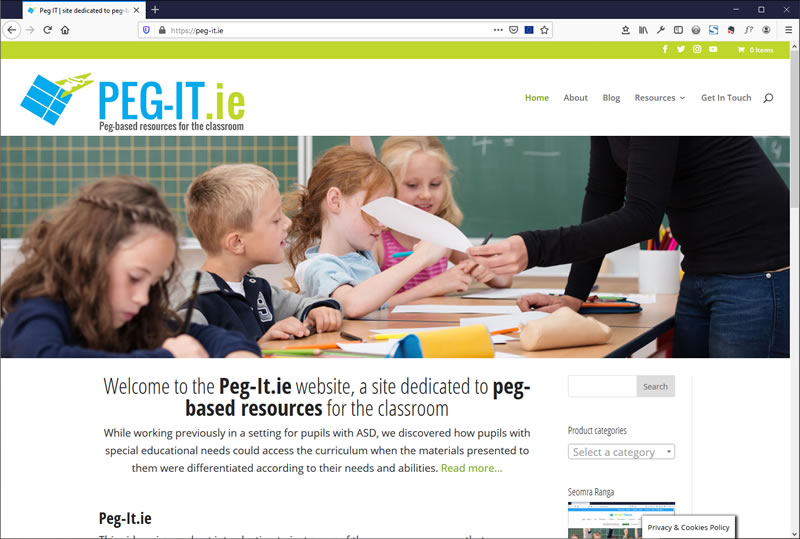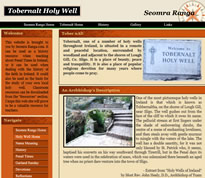 What can be a big problem when trying to solve maths problems? For some children they just can’t picture or visualise what is happening in the problem. If this is something you notice in your class, then I’d really recommend you check out Thinking Blocks, an excellent free maths learning tool that uses blocks to model and solve basic maths problems from topics like addition, multiplication, fractions, and ratio. Through these activities, students learn how to model each maths problem, as well as identify known and unknown quantities. Ultimately it also develops their ability to visualise the quantities in a problem and to construct models themselves of other problems.
What can be a big problem when trying to solve maths problems? For some children they just can’t picture or visualise what is happening in the problem. If this is something you notice in your class, then I’d really recommend you check out Thinking Blocks, an excellent free maths learning tool that uses blocks to model and solve basic maths problems from topics like addition, multiplication, fractions, and ratio. Through these activities, students learn how to model each maths problem, as well as identify known and unknown quantities. Ultimately it also develops their ability to visualise the quantities in a problem and to construct models themselves of other problems.
I often demonstrate this website on courses; however if you’ve never seen this site in action before, I’d recommend you start by going to the addition and subtraction section of the site and clicking on the Watch Video option at the bottom of the screen. This gives you a brief tutorial and explains the options that are available to you. You may notice that at the top of the screen, it only mentions Addition; however when this section opens the heading is for both addition and subtraction problems, which makes sense, since one operation is the inverse of the other.
Depending on the ability of the children, and whether this was being presented in a whole class setting or for a student’s individual use, I would say that the addition and subtraction sub-topic would be suitable for 2nd class and upwards. The Multiplication (and division) page would be very suitable for 3rd classes and upwards, and Fractions probably for 5th and 6th classes with Ratios for 6th class only.
Ways to use this in class:
· Do a whole class demonstration on the IWB, ask children to come up and place the labels/numbers etc in the correct place.
· If you have PCs/laptops (this uses Flash so it won’t work on iPads etc*), the children could work through a given section, individually or in pairs. This could be all at the same time, or could be used as a station if doing station teaching. Alternatively the children could use a PC/laptop in turn, during the school day, with the goal being to complete a sub-topic. In my school, we have a laptop trolley with 16 laptops so I usually get all the children working at the same time in pairs, after doing a quick whole class demo on the IWB.
· There are five problems in each sub-topic (each sub-topic is based on a different model) which enables the learner to have a good amount of practice for one sub-topic before moving on to the next one. The problems get more complicated as you go from one sub-topic to another, and you have a good amount of choices for sub-topics. The word problems in each sub-topic also seem to be randomly generated, so if a student needed extra practice they could repeat that sub-topic, and would get five different problems, while still based on the same type of model. There is a random option which mixes up the sub-topics and can be used if the user wants to mix things up!
· Ultimately, the aim should be to give the students enough experience of using this tool in a structured and scaffolded way, so that they consider drawing their own thinking blocks as a means to solve the problems they come across in class, or as part of homework.
Thinking blocks were developed to reflect the model drawing approach, one of the central methodologies in Singapore Maths. Many of the problems are also based on Part-Whole relationships ie. if the whole number is 30, this can be split into parts e.g. 20+10, 5+15+10 etc. And if we understand this relationship, we should be able to work out the value of a missing/unknown quantity (e.g. one part), if given all the other quantities.
However, thinking blocks or model drawing is only one way that students can represent maths in a pictorial/visual way. Other strategies include using a blank/open number line (c.f. the article ‘Keeping Numbers on Track‘ in InTouch November 2012) as well as drawings, diagrams, charts and graphs. Of course, use of any of these strategies should always be second in line to concrete exploration i.e. using concrete or physical manipulatives to represent/model the problem where possible.
Thinking Blocks iPad App
Thinking Blocks have just been released as (free for a limited time) iPad apps; download them soon as they will be paid apps after 15 Aug. Search for Thinking Blocks in the iTunes Store. Follow the links below to the iTunes Store:
♦ Thinking Blocks Multiplication
Seomra Ranga would like to express its thanks to Claire Corroon for permission to re-publish this post which first appeared on her own website Primary CPD on which she posts resources and links to websites which are useful to primary school teachers.





